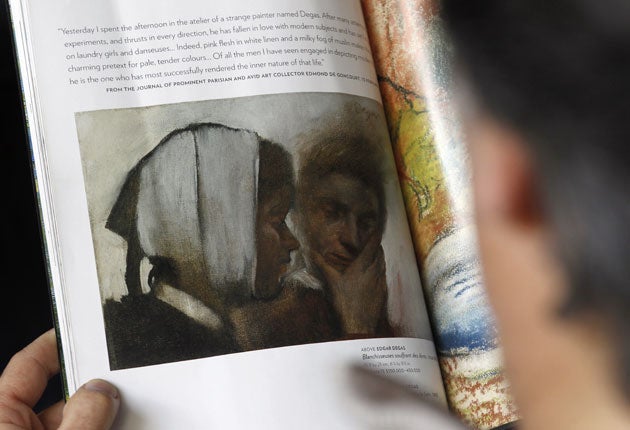Stolen Degas returned to France after 37 years
Ownership of tiny Impressionist masterpiece was written in code on reverse, but hidden by frame

A small but very precious painting by Edgar Degas, stolen from a French museum 37 years ago, has been returned to its rightful owners. This outcome, the culmination of a mystery still not entirely solved, illustrates what might charitably be called the inefficiencies of the art world when it comes to identifying works whose provenance is criminal rather than legitimate.
The modern adventures of the unappetisingly entitled Laundry Women with Toothache begins in France. The painting, completed by Degas in the early 1870s, had been given by a collector to the Louvre, but in 1961 was lent to the Malraux Museum in Le Havre, Normandy. There it safely remained, until, in 1973, a thief grabbed it from the wall and made off with it. His or her identity is still unknown.
The trail, as is so often the case with stolen works by famous artists, then went very cold. Nothing more was publicly heard of the painting until late last year, when it was featured in a Sotheby's catalogue for a sale in November of Impressionist art. The tiny oil portrait, only 6.25in by 8.5in, of a young woman holding her jaw was given an estimated value of $350,000 to $450,000 (£218,000-£281,000). However, an employee of the Malraux Museum spotted it in the listing, contacted Interpol, US Homeland Security Investigations special agents became involved, and Sotheby's immediately withdrew it from the sale. It was duly handed to the acting French ambassador to the US on Friday.
The seller, Ronald Grelsamer, a surgeon from Manhattan, said he had received the painting from his father, who knew nothing of its criminal past. The family has the right to file a claim for compensation from French authorities. Sotheby's officials said that before the auction, they had checked to see if the piece was noted on the London-based Art Loss Register, which tracks stolen, looted or missing art, and similar databases. But they said they did not find it listed.
There are now questions to be asked about the completeness of such databases, and the thoroughness of inquiries about the provenance of a painting. It turns out that stencilled on the back of the canvas, but hidden by the frame, was "RF 1953-8" – shorthand for its being the eighth work of art acquired by the French Republic in 1953. A check for such a mark, and a check with major French museums ought, one would imagine, to be routine.
Sotheby's official Diana Phillips said the auction house "is happy to have been able to be involved in this discovery and we are pleased that this painting will be returned to the government of France". The seller, she added, "was shocked to learn about this and throughout has been extremely cooperative".
An investigation continues into the painting's whereabouts before it came into the possession of Mr Grelsamer's father.
Subscribe to Independent Premium to bookmark this article
Want to bookmark your favourite articles and stories to read or reference later? Start your Independent Premium subscription today.

Join our commenting forum
Join thought-provoking conversations, follow other Independent readers and see their replies